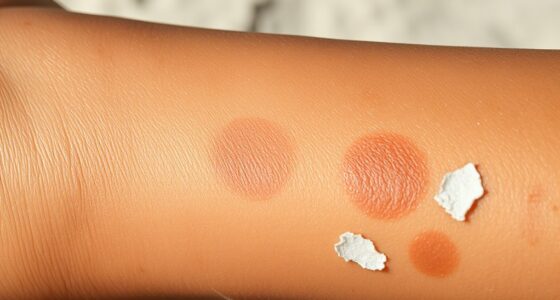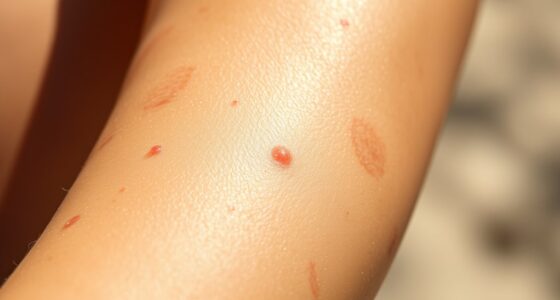Tanning damages your skin’s elastic fibers, causing them to break down and weaken your skin’s ability to bounce back. UV rays, especially UVA, also break down collagen, leading to sagging, wrinkles, and age spots. Over time, this accelerates skin aging and decreases hydration, making your skin thinner and less resilient. Keep going, and you’ll discover how to protect and restore your skin’s youthful firmness effectively.
Key Takeaways
- Tanning damages elastic fibers, reducing the skin’s ability to bounce back and maintain firmness.
- UV exposure breaks down collagen, leading to decreased skin elasticity and increased sagging.
- UVA rays penetrate deeper, harming elastin fibers essential for skin’s resilience.
- Repeated tanning accelerates collagen and elastin deterioration, causing premature skin aging and loss of elasticity.
- Damage from tanning impairs skin repair processes, resulting in thinner, less resilient skin over time.
The Impact of UV Exposure on Skin Firmness
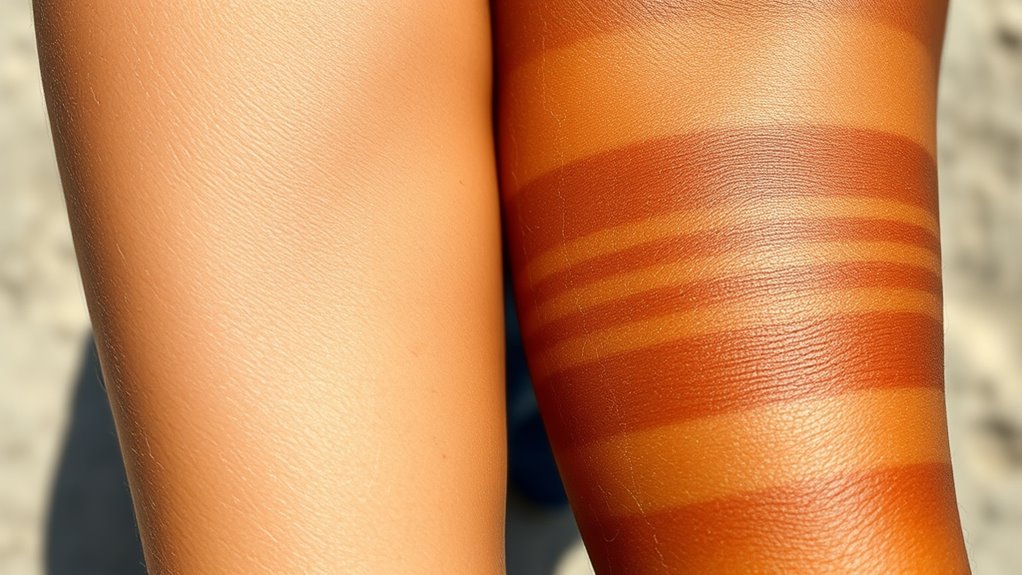
UV exposure directly impacts your skin’s firmness by damaging its elastic fibers. UVA and UVB rays penetrate your skin, with UVA reaching deeper to harm elastin fibers. When these fibers break down, your skin loses its ability to bounce back after stretching, leading to sagging. Over time, this damage accumulates, causing wrinkles, fine lines, and age spots that further reduce firmness. UV radiation triggers a biological response, increasing reactive oxygen species (ROS) and matrix metalloproteinases (MMPs), which accelerate elastin degradation. The result is skin that feels less tight, more coarse, and uneven in texture. If you don’t protect your skin from UV rays, these harmful effects build up over the years, making your skin appear older and less resilient. Additionally, proper skincare, including the use of antioxidants and moisturizers, can help mitigate some of the damage caused by UV exposure. Implementing UV protection strategies like sunscreen and protective clothing is essential for maintaining skin elasticity over time. Regular use of antioxidants can also neutralize free radicals generated by UV rays, further preventing elastin breakdown. Incorporating advanced skincare technologies, such as peptide treatments, may further support skin firmness and repair existing damage. Moreover, using hydrating products can help maintain skin elasticity by supporting the skin’s moisture barrier and overall resilience.
Collagen Breakdown and Its Role in Aging

As you age, your skin naturally produces less collagen, a key protein that keeps your skin firm and elastic. This decline, about 1.0%-1.5% annually, weakens skin structure, making it thinner and less resilient. Collagen types, especially Type I, are essential for maintaining skin strength and elasticity. Over time, collagen fibers break down and become disorganized, further reducing skin firmness. Hormonal changes, like declining estrogen, accelerate collagen loss, while aging fibroblasts become less efficient at producing new collagen. This process leads to decreased skin volume, the formation of wrinkles, and a loss of elasticity. As collagen diminishes, your skin’s ability to bounce back worsens, making it more prone to sagging and other signs of aging. Understanding the collagen breakdown process can help you take steps to support your skin’s health and resilience, especially considering how external factors like UV exposure can further accelerate collagen deterioration. Additionally, lifestyle choices such as smoking and poor nutrition can exacerbate collagen loss, highlighting the importance of a holistic approach to skin health. Factors like environmental stressors can also contribute to collagen degradation, emphasizing the need for comprehensive skin care strategies.
Visible Signs of Skin Damage From Tanning
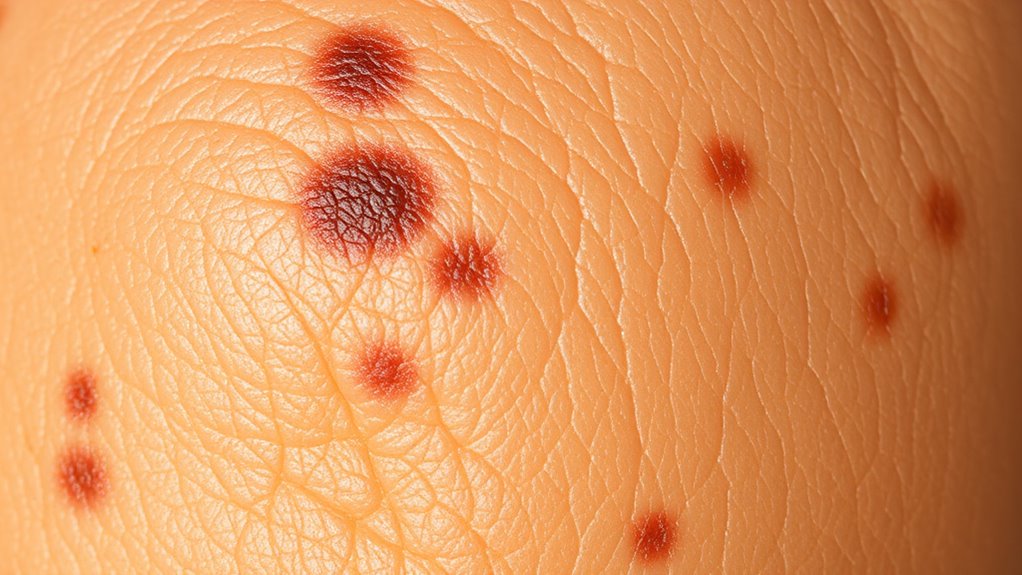
Tanning visibly damages your skin, leaving clear signs that your skin has been exposed to harmful radiation. You might notice wrinkles and fine lines forming faster, a sign that your skin’s elasticity is breaking down. Brown spots and hyperpigmentation can appear as uneven patches, showing sun damage over time. Dark spots and melasma become more prominent, especially with frequent exposure. You may also see broken blood vessels near the surface of your skin, giving a blotchy appearance. Redness and irritation, particularly on your neck, often occur after tanning sessions. These visible signs serve as warning indicators that your skin has undergone damage from UV radiation, compromising its health and appearance. Recognizing these signs can motivate you to protect your skin better. Overheating risks of tanning devices highlight the importance of understanding potential skin damage. Additionally, prolonged exposure can lead to skin aging, accelerating the development of these visible damage signs. Awareness of AI-driven safety measures in tanning technology could help mitigate some risks associated with UV exposure. Incorporating creative approaches to skin care and sun protection can also empower you to maintain healthier skin despite environmental challenges.
How Tanning Accelerates the Aging Process

Exposure to UV radiation directly damages your skin’s structural proteins, particularly collagen fibers, leading to a loss of firmness and elasticity. UV exposure accelerates collagen breakdown, weakening the skin’s foundation and promoting sagging. It also causes DNA mutations in skin cells, speeding up cellular aging and impairing repair mechanisms. Over time, this damage results in thinner dermal layers, increased wrinkle formation, and a leathery texture. UV stimulates enzymes that degrade hyaluronic acid and elastin, reducing skin’s resilience and moisture retention. Chronic exposure diminishes fibroblast activity, impairing new collagen production and weakening extracellular matrix cohesion. These combined effects cause irreversible structural changes, including dermal thinning, microvascular damage, and loss of subcutaneous fat. All these factors contribute to premature skin aging, making your skin look older faster. Incorporating skin protection strategies such as sunscreen use and avoiding peak UV hours can help mitigate some of these damaging effects.
The Effect of UV Rays on Skin Hydration
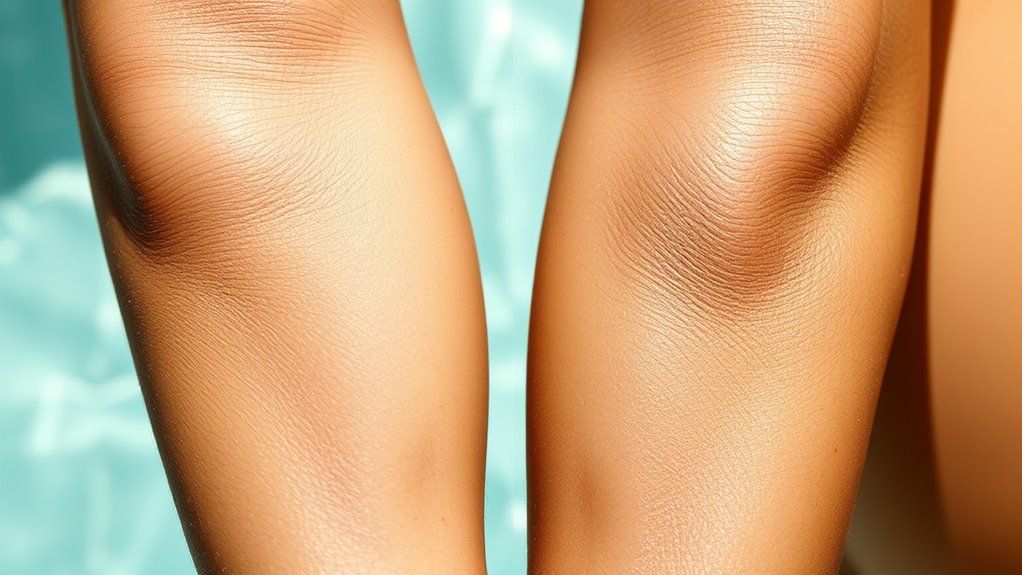
UV rays don’t just damage the structural proteins in your skin; they also disrupt your skin’s ability to stay hydrated. When exposed, UV radiation harms the outer layer, impairing its capacity to retain water and lipids essential for moisture. Initially, UVB exposure may cause a temporary increase in hydration due to lipid changes, but prolonged exposure depletes the skin’s moisture barrier. This leads to chronic dryness, flakiness, and increased water loss. The damage weakens keratin and intercellular lipids, making your skin more permeable and less able to hold water. As dehydration continues, your skin becomes rough, irritated, and less elastic. Over time, this impaired hydration hampers cellular repair and collagen production, accelerating signs of aging and reducing overall skin resilience. Understanding skin structure helps explain how UV damage compromises hydration and elasticity over time.
Strategies to Restore Skin Elasticity After Tanning
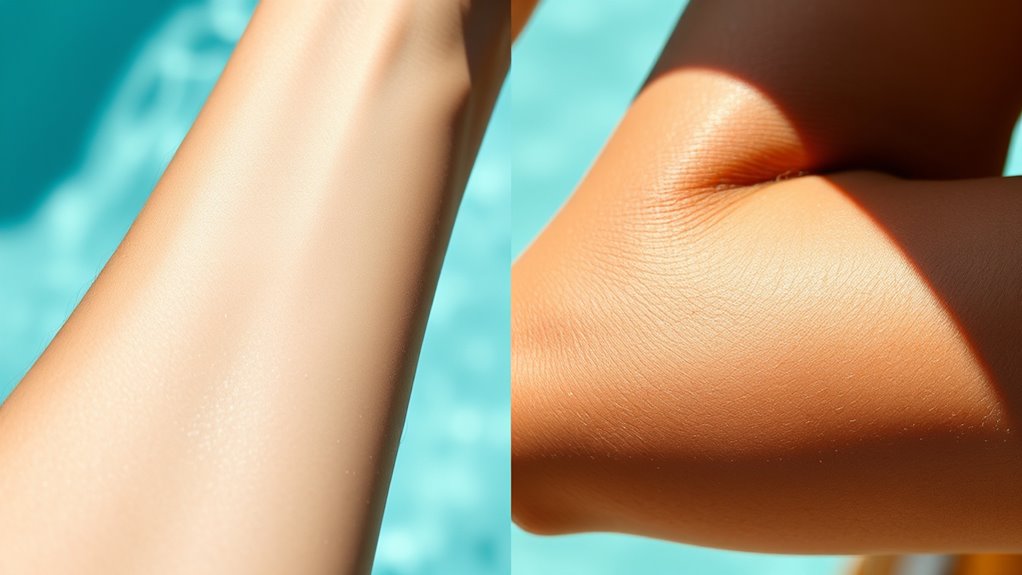
Restoring skin elasticity after tanning involves targeted treatments that stimulate collagen production and boost hydration. Using retinoids or retinol-based products helps enhance collagen synthesis and encourages skin renewal, especially when combined with antioxidants like vitamin C. Over-the-counter retinol offers milder effects, while prescription options deliver stronger results to reverse photoaging caused by UV exposure. Hyaluronic acid-based serums and creams replenish moisture, trapping water to improve skin plumpness and elasticity. Incorporating collagen production techniques can further support skin rejuvenation and firmness. For more significant damage, professional procedures like microneedling, laser treatments, or ultrasound therapy stimulate collagen production and tighten skin over time. Additionally, antioxidant-rich serums support DNA repair and protect against free radicals, preventing further damage. Incorporating professional-grade skincare devices can further enhance collagen stimulation and skin tightening. Using reliable skincare products with proven ingredients ensures consistent results and reduces the risk of irritation. A comprehensive approach that includes lifestyle adjustments, such as staying hydrated and avoiding excessive sun exposure, can also significantly contribute to maintaining skin elasticity over time. Regular use of hydrating serums supports long-term skin resilience and prevents further loss of elasticity.
Benefits of Collagen Supplements for Skin Health

Collagen supplements offer a practical way to improve your skin’s elasticity and overall health. Studies show that hydrolyzed collagen markedly boosts skin firmness and suppleness within 8 to 12 weeks of daily use. It doesn’t matter whether you choose bovine or marine collagen—both are effective. When you take collagen regularly, you’ll notice increased skin hydration, which helps reduce fine lines and improves texture. Collagen also supports your skin’s barrier, protecting it from environmental damage and UV exposure. Plus, these supplements stimulate your body’s natural collagen production, counteracting age-related decline. For best results, pairing collagen with vitamin C enhances synthesis. Overall, collagen supplements can contribute to healthier, more elastic skin, making them a valuable addition to your skincare routine—especially after tanning or sun exposure. Regular supplementation may also support skin elasticity, further improving your skin’s resilience over time.
Preventive Measures to Protect Skin Elasticity
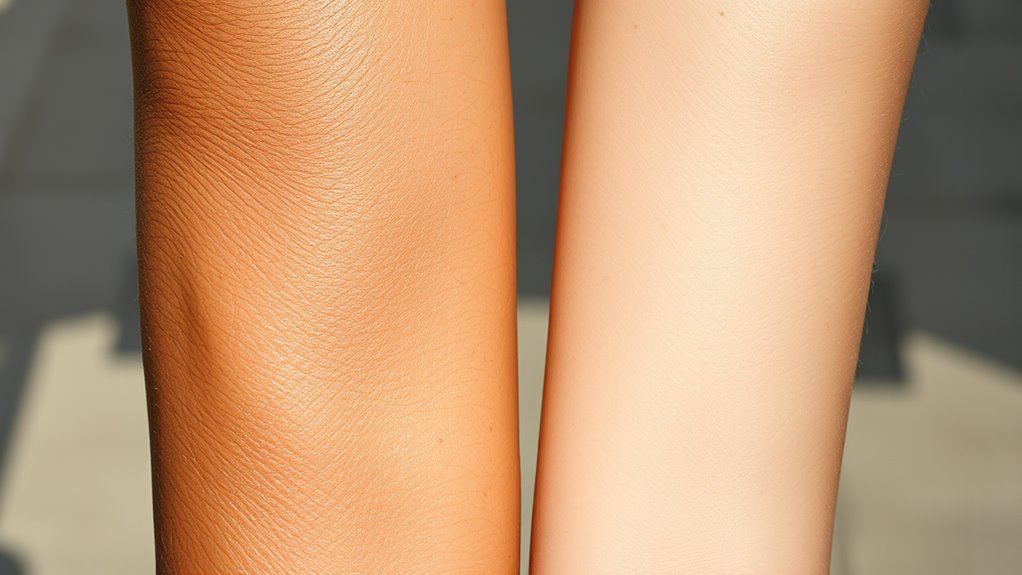
Protecting your skin’s elasticity requires proactive measures that minimize damage from environmental factors. Start by applying broad-spectrum sunscreen daily, especially during peak sun hours from 11 a.m. to 3 p.m., and wear protective clothing or seek shade to block UV rays, which break down collagen and elastin. Incorporate antioxidants like vitamin C into your skincare routine and eat antioxidant-rich foods to combat free radicals caused by pollution and sun exposure. Keep your skin well-hydrated with hyaluronic acid-based moisturizers that restore moisture and improve elasticity. Additionally, maintaining a wide color gamut in your skincare products can help enhance the visual quality of your skin’s appearance. Finally, adopt healthy habits such as maintaining a balanced diet, avoiding smoking and excessive alcohol, and staying active. These steps help preserve your skin’s natural resilience and slow premature aging. Additionally, protecting your skin from environmental stressors like pollution can help maintain skin elasticity over time.
Medical and Cosmetic Treatments for Skin Rejuvenation

When skincare routines and preventive measures fall short, medical and cosmetic treatments offer effective options for skin rejuvenation. Laser skin resurfacing uses ablative and non-ablative lasers to target wrinkles, sun damage, and scars, stimulating collagen production for long-lasting improvements. Chemical peels remove damaged outer skin layers, promoting new, firmer skin while reducing fine lines and pigmentation. Injectable treatments like Botox relax muscles to smooth dynamic wrinkles, while dermal fillers restore lost volume, enhancing skin firmness. Mechanical techniques such as microdermabrasion and microneedling physically stimulate collagen, improving texture and elasticity. These procedures often require multiple sessions and professional expertise but provide significant rejuvenation when combined with proper skin care. Regular treatments can help reverse some effects of tanning, aging, and sun damage, restoring a more youthful, resilient appearance.
Lifestyle Changes to Maintain Skin Firmness

Maintaining skin firmness requires consistent lifestyle habits that support overall skin health. Staying well-hydrated by drinking plenty of water keeps your skin moist and elastic. Eating a balanced diet rich in collagen, vitamin C, antioxidants, and omega-3s boosts skin strength from within. Prioritize quality sleep to aid skin regeneration and repair. Regular exercise improves circulation, delivering nutrients that enhance firmness. Manage stress through relaxation techniques like meditation or yoga, which minimizes negative effects on your skin. Use sunscreen daily to protect against UV damage, and avoid pollution and smoking to prevent premature aging. Adopt a gentle skincare routine with hydrating ingredients like hyaluronic acid, and exfoliate regularly to maintain smooth, firm skin. These habits work together to preserve your skin’s elasticity over time.
Frequently Asked Questions
Can Tanning Cause Long-Term Skin Elasticity Loss?
You might wonder if tanning can harm your skin long-term. The answer is yes. UV rays from tanning damage elastin and collagen, which are essential for maintaining skin’s firmness and elasticity. Over time, this damage causes your skin to become thinner, saggy, and wrinkled. Frequent tanning accelerates aging and can lead to permanent elasticity loss, making it harder for your skin to bounce back, even years later.
How Does Collagen Supplementation Help Reverse Tanning Damage?
Imagine your skin as a delicate tapestry, easily frayed by harsh UV rays. Collagen supplements act like skilled artisans, weaving new fibers into this fabric. They provide the building blocks your skin needs to rebuild lost collagen, restoring firmness and elasticity. By supporting skin regeneration and reducing wrinkles, these supplements help heal tanning damage, making your skin look refreshed, resilient, and youthful again—like a vibrant tapestry renewed.
Is Sunless Tanning Safer for Skin Elasticity Than UV Tanning?
You wonder if sunless tanning is safer for your skin’s elasticity than UV tanning. Sunless tanning, using DHA, causes less immediate damage since it doesn’t involve UV rays that break down elastin and collagen. While long-term effects of DHA are still being studied, it’s generally safer and less likely to cause sagging or wrinkles. To protect your skin, limit exposure and moisturize regularly, regardless of your tanning choice.
What Are the Earliest Signs of Tanning-Related Skin Aging?
You’ll notice early signs of tanning-related skin aging as your skin begins to develop fine wrinkles, especially around sun-exposed areas. Dark spots like age spots or freckles may appear, and your skin might feel rough or leathery over time. You could also see redness, blotchiness, or broken blood vessels. These changes happen because UV damage breaks down collagen and elastin, leading to loss of firmness and early aging signs.
Can Skincare Routines Fully Restore Elasticity After Tanning Exposure?
Skincare routines can’t fully restore your skin’s elasticity after tanning exposure. While products like collagen supplements and moisturizers can help improve hydration and support collagen production, they can’t repair DNA damage or fully regenerate lost collagen. Chronic UV damage often causes irreversible changes, making prevention better than cure. To protect your skin’s elasticity long-term, prioritize sun protection, healthy lifestyle habits, and professional treatments when needed.
Conclusion
While it might seem tempting to tan for a sun-kissed glow, remember that UV exposure accelerates skin aging and damages elasticity. Don’t let the desire for quick results outweigh your skin’s long-term health. Using sunscreen, staying hydrated, and considering collagen supplements can help safeguard your skin. Even if you worry about missing out on tanned skin, embracing your natural tone and caring for your skin now ensures a youthful, firm complexion for years to come.


